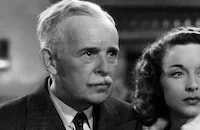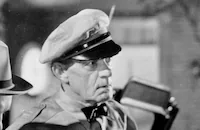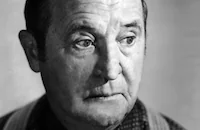Thunder Afloat

Brief Synopsis
Cast & Crew
George B. Seitz
Wallace Beery
Chester Morris
Virginia Grey
Douglas Dumbrille
Carl Esmond
Film Details
Technical Specs

Synopsis
During World War I, off the New England coast, German submarines prey on United States shipping vessels and are in turn hunted down by the subchasers of the splinter fleet. Operating in these hostile waters are John Thorson, a rowdy tugboat skipper, and his business competitor, Rocky Blake, an equally foul-tempered skipper. Thorson and his daughter Susan contrive to eliminate their competitor by tricking Rocky into joining the Navy, but when Thorson's beloved tug is sunk by a German U-Boat, he becomes so enraged that he also enlists in the Navy, determined to wage a one man war on the subs. Outspoken and undisciplined, Thorson disobeys orders and takes a subchaser out of formation to start his own hunt for the U-Boats. For his insubordination, Thorson is court-martialled, found guilty, demoted from ensign to ordinary seaman, and then assigned to land duty. He is about to desert when Rocky, now a subchaser division chief, is assigned to command a mystery schooner to decoy the subs and enlists Thorson in his crew. While attempting to ram the U-Boat that sunk his tug, Thorson is captured by the crippled sub, a target of the splinter fleet's depth charges. Miraculously, Thorson manages to signal the location of the sub, and when it is forced to the surface by the sub chasers, he is rescued. For his heroic actions, Thorson is decorated and reinstated to his former rank of ensign. After bidding Susan farewell, Rocky, Thorson and the fleet set sail for France.

Director
George B. Seitz
Cast

Wallace Beery

Chester Morris

Virginia Grey

Douglas Dumbrille

Carl Esmond

Clem Bevans

John Qualen

Regis Toomey
Henry Victor

Addison Richards
Hans Joby
Henry Hunter

Jonathan Hale

Charles Lane

Phillip Terry
Wade Boteler
Harry Strang
Jack Chapin
Lee Frederic
Doodles Weaver
Mitchell Lewis
Tom Chatterton
Forbes Murray

Emmett Vogan
Frank Faylen

Leon Ames
Leigh De Lacy

Rand Brooks
Clarke Jennings
Dutch Schlickenmayer
Allen Fox
Dick Elmore

Howard Hickman

Roger Moore
Ed J. Lesaint
Don Castle
Edgar Dearing

Lew Kelly
Lee Shumway

Frank Orth
Milton Kibbee
Philip Morris
Earle Hodgins
Eddie Hart
Edward Hearn
Al Bridge
Jack Kennedy
Joe Bernard
Art Belasco
Joe De Stefani
George Guhl
Syd Saylor
Bob Stevenson
Hans Von Morhart
Hans Schumm
Bud Fine
Walter Thiele
Jack Clifford
Wolfrem Von Bock
Ferdinand Schumann-heink
Charles Johnson
Larry Mcgrath

Claire Mcdowell
Crew
Tom Andre
Bud Braybill
A. W. Brown
Capt. C. F. Cook
Jack Etra
Howard Fellows
Ray Foreman
Cedric Gibbons
Irving Glassberg
Commander Harvey Haislip
Commander Harvey Haislip
Frank E. Hull
Charles Hunt
Stanley Hutchison
Lloyd Isbell
Urie Mccleary
William Miller
Tom Ordoqui
Wells Root
J. Walter Ruben
Bob Saunders
John Scura
John Seitz
Douglas Shearer
Ralph Shugart
Julien Silberstein
David Snell
William Strong
Dolly Tree
Valles
Neil Wakeman
Edward Ward
Ralph Wheelwright
Edwin B. Willis
Charles Wynn

Film Details
Technical Specs

Articles
Thunder Afloat (1939) -
A bizarre WWI potboiler about an irascible New England shipping captain wrestling his way through duty with the Naval Reserve - which, the film's opening title tells us, actively hunted and sank German u-boats off the Atlantic coast - Thunder Afloat is a Wallace Beery vehicle top to bottom, which by 1939 meant that it was a small-budgeted, low-ambition affair. Though Beery was one of Hollywood's top 10 moneymakers throughout the '30s, by the time WWII was under way, his career limped along with unofficial B pictures, mostly comedies and wartime propaganda, until his death in 1949. When Joel and Ethan Coen had their titular hero in Barton Fink (1991) - a pretentious Odets-like playwright gone to Hollywood on contract - face the prospect of scripting a "Wallace Beery wrestling movie," something like the lowest order of business within the vast studio machine, a programmer like Thunder Afloat is what they had in mind. (Beery did actually make one wrestling film, the John Ford-directed Flesh, back in 1932, which was co-written by a slumming William Faulkner - a version of whom also figured prominently in Fink. Unbelievably, the Coens didn't know anything about the rarely-screened Flesh until after their film was completed.)
Surely forgotten in every sense by 1940, the film plays almost like a formula project that made itself according to a Hollywood-screenplay program, without supervision. Beery's splenetic tug owner, abetted by devoted daughter Virginia Grey, nurtures a rivalry with Chester Morris's port-town competitor, and eventually tricks him into signing up for the Reserve. But then Beery's slovenly oaf, exploiting the contracts left open by Morris's departure, confronts a German sub out at sea - and has his ship sunk for his trouble. Signing up himself now, he ends up on the same sub-hunter as Morris, but as Morris's subordinate - and a predictable clash of stubborn pride and military duty commence to take the old hog down several pegs, and then allow him to redeem himself heroically in the end, just in time for Morris and Grey to realize a romance.
The story is stock, but the film's historical placement is anything but. In 1939 the United States was still officially neutral in the gathering storm of WWII in Europe and Asia, and anti-German films were still virtually verboten. Instead, the filmmakers (including Andy Hardy-bound director George B. Seitz and original writer Commander Harvey Haislip) used the circumstances of 1917 as a proxy for new wartime propaganda. This remains an odd strategy, however, because films about WWI, made in Hollywood and elsewhere, were hardly ever flag-wavers, and almost never indulged in naked nationalism. The carnage-saturated and morally ambivalent legacy of the Great War was such that every culture's take on it in the subsequent decades was marked by rue, sorrow and often a sense of brotherly empathy for the enemy in question. Everyone who fought in that war experienced the conflict itself as their ultimate adversary, and the "filthy Hun" propaganda created by various governments during the fighting was quickly superseded by the pointless horror of the battlefield itself.
Thus, the bullheaded patriotism manifested in Thunder Afloat is a message out of time, pinned awkwardly to the Great War but actually targeted ahead, at the conflict to come. As it is, anachronisms are thick on the ground, from Grey's late-'30s couture to much of the naval footage of the submarines, which are distinctly interwar models, not the submersible war ships of 1914. (The impressive "Y gun" depth charge delivery system on view wasn't available until the very end of the war.) As a result, Thunder Afloat is very much a film of its precarious moment, more revealing of the day of its release than of the year in which the narrative is ostensibly set, necessarily without a single swastika or mention of Hitler.
Still, Beery was the main attraction of the day, and he's a spectacle - one of the weirdest movie stars Hollywood has ever produced, a belligerent, slow-thinking, hard-drinking yokel with slow reflexes and, though commonly cast in comedies, an unmistakable capacity for brute violence. (There is evidence that he helped beat Three Stooges creator Ted Healy to death in 1937, and Gloria Swanson claimed in her memoir that he'd raped her on their wedding night in 1917, and then forced her to drink an abortifacient.) A certain substantial chunk of the movie-going public - much of it in the South and the Midwest - loved Beery's low-class overacting and deliberate country-bumpkin grumpiness, evoking for many their own aging fathers, uncles and hometown curmudgeons. Today, Beery's charm, like Jackie Gleason's and Seth Rogen's after him, is an acquired taste, but an indelible facet of American life between the wars.
By Michael Atkinson

Thunder Afloat (1939) -
Virginia Grey (1917-2004)
She was was born in Los Angeles on March 22, 1917, and was exposed to the film industry at a very young age. Her father, Ray Grey, was a Keystone Cop and acted in several other of Mack Sennett's comedies with the likes of Mabel Normand, Dorothy Gish and Ben Turpin. When her father died when she was still a child, Virginia's mother encouraged her to join the acting game and audition for the role of Eva for Uncle Tom's Cabin, a big budget picture for Universal Studios in the day. She won the role, and acted in a few more pictures at the studio: The Michigan Kid and Heart to Heart (both 1928), before she decided to temporarily leave acting to finish her schooling.
She returned to films after graduating from high school, and after bouncing around Hollywood doing bits for various studios, she hooked up with MGM in 1938. Her roles in her first few films were fairly non-descript: In Test Pilot and Ladies in Distress (both 1938), she did little more than look pretty, but in the following year she had scene-stealing parts in The Women (upstaging Joan Crawford in a delicious scene as a wisecracking perfume counter girl) and as the suffering heroine in Another Thin Man (both 1939).
Despite her versatility (she could handle comedy or drama with equal effectiveness), MGM would cast her in some above-average, but hardly starmaking movies: Whistling in the Dark, The Big Store (both 1941), and Tarzan's New York Adventure (1942). She left MGM in 1943 and became a freelance actress for several studios, but her material as a leading lady throughout the '40s were mediocre: Swamp Fire, House of Horrors (both 1946), and Mexican Hayride (1948) were sadly the more interesting films in her post-MGM period. But by the '50s she was a well-established character actress, appearing in fairly big-budget pictures: All That Heaven Allows, The Rose Tattoo (both 1955), Jeanne Eagels (1957).
In the '60s, Grey turned to television and found work on a variety of hit shows: Wagon Train, Peter Gunn, Bonanza, My Three Sons, I Spy, and several others; plus she also captured a a couple of notable supporting parts in these films: Madame X (1966), and Airport (1970), before retiring completely from acting in the early '70s. She is survived by her sister, Lorraine Grey Heindorf, two nieces and two nephews.
by Michael T. Toole
Virginia Grey (1917-2004)
Quotes
Trivia
Because war broke out in Europe in September 1939, MGM released this film a month earlier than scheduled.
Notes
According to pre-production news items in Hollywood Reporter, M-G-M wanted Barbara Stanwyck for the female lead, but she was unavailable to appear. Franchot Tone was originally scheduled for the male romantic lead, but was forced to withdraw because of illness. The submarine sequences were shot with the cooperation of the U. S. Navy at Annapolis, MD and around the Coronado Islands off San Diego, CA. Production records contained in the George B. Seitz papers at the AFI library add that this picture was also filmed on location at San Pedro, CA from May-June 1939. Other news item in Hollywood Reporter note that the picture as budgeted at $1,000,000 and that M-G-M released it one month ahead of schedule to benefit from "war fever" following the eruption of war in Europe in early September 1939.















